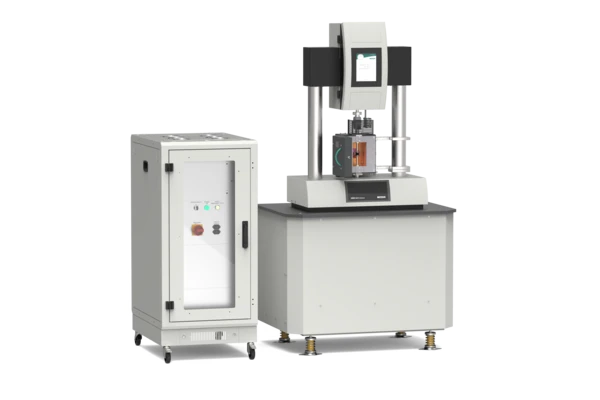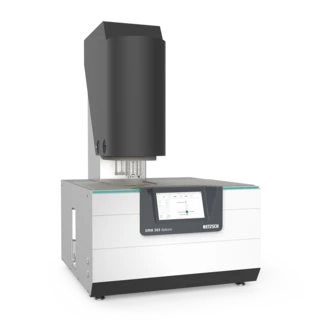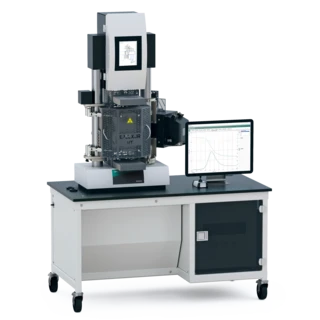Highlights
Accurate measurements of heat build-up or blowout processes and the determination of the thermal set can be realised by our HBU 523 Gabometer system – a development based on the established Goodrich Flexometer.
Both force- and elongation-controlled tests can be carried out with this state-of-the-art type of flexometer. The HBU 523 Gabometer is suitable for improving the thermal dissipation and the durability of semi-finished tire components, dampers or absorbers.
Additionally, the new generation allows for measurement of the material stiffness (E modulus, tanδ option) and damping.
Your Advantages
- Heat build-up and blowout tests according to Goodrich (DIN 53533, ASTM D 623, ISO 4666/3, ISO 4666/4, BS 903 part A50 and JIS K 6265)
- Goodrich flexometer tests
- Static: StrainStrain describes a deformation of a material, which is loaded mechanically by an external force or stress. Rubber compounds show creep properties, if a static load is applied.strain or StressStress is defined as a level of force applied on a sample with a well-defined cross section. (Stress = force/area). Samples having a circular or rectangular cross section can be compressed or stretched. Elastic materials like rubber can be stretched up to 5 to 10 times their original length.stress controlled load mode available
- Dynamic: StrainStrain describes a deformation of a material, which is loaded mechanically by an external force or stress. Rubber compounds show creep properties, if a static load is applied.strain or StressStress is defined as a level of force applied on a sample with a well-defined cross section. (Stress = force/area). Samples having a circular or rectangular cross section can be compressed or stretched. Elastic materials like rubber can be stretched up to 5 to 10 times their original length.stress controlled load mode available
- Wide frequency range (option)
- Wide temperature range (option)

- Automatic Sample Changer (ASC) for fully automatic testing (24h) (option)
- Simultaneous measurement of the visco-elastic properties (option)
- Visco-elastic properties in DMTS/DMA mode (option)
- Hysteresis analysis (option)
- Pulse load mode available (option)
Method
Dynamic Mechanical Analysis (DMA) provides valuable insights into various aspects of material behavior. It offers information on viscoelastic properties such as storage and Viscous modulusThe complex modulus (viscous component), loss modulus, or G’’, is the “imaginary” part of the samples the overall complex modulus. This viscous component indicates the liquid like, or out of phase, response of the sample being measurement. loss modulus, loss factor, and tan δ.
Additionally, DMA allows the examination of stiffness and damping properties under diverse conditions, including temperature, frequency, StressStress is defined as a level of force applied on a sample with a well-defined cross section. (Stress = force/area). Samples having a circular or rectangular cross section can be compressed or stretched. Elastic materials like rubber can be stretched up to 5 to 10 times their original length.stress, StrainStrain describes a deformation of a material, which is loaded mechanically by an external force or stress. Rubber compounds show creep properties, if a static load is applied.strain, gas atmosphere, and liquid environments. It facilitates the identification of material reactions, Phase TransitionsThe term phase transition (or phase change) is most commonly used to describe transitions between the solid, liquid and gaseous states.phase transitions, and the Glass Transition TemperatureThe glass transition is one of the most important properties of amorphous and semi-crystalline materials, e.g., inorganic glasses, amorphous metals, polymers, pharmaceuticals and food ingredients, etc., and describes the temperature region where the mechanical properties of the materials change from hard and brittle to more soft, deformable or rubbery.glass transition temperature of highly cross-linked polymers and composites.
Moreover, DMA aids in assessing the compatibility of polymer blends based on composition and structure, as well as the impact of filler and additive contents. It also helps in understanding Curing (Crosslinking Reactions)Literally translated, the term “crosslinking“ means “cross networking”. In the chemical context, it is used for reactions in which molecules are linked together by introducing covalent bonds and forming three-dimensional networks.curing and post-Curing (Crosslinking Reactions)Literally translated, the term “crosslinking“ means “cross networking”. In the chemical context, it is used for reactions in which molecules are linked together by introducing covalent bonds and forming three-dimensional networks.curing processes of resins, analyzing aging influences, and predicting material behavior through Time-Temperature-Superposition (TTS).
Furthermore, DMA enables the study of CreepCreep은 일정한 힘 아래에서 시간과 온도에 따라 달라지는 소성 변형을 나타냅니다. 고무 화합물에 일정한 힘이 가해지면 가해진 힘에 인해 발생하는 초기 변형이 고정되지 않습니다. 변형은 시간이 지남에 따라 증가합니다creep and RelaxationRelaxation은 고무에 일정한 변형률이 가해지면, 변형률을 유지하기 위해 필요한 힘은 일정하지는 않지만 시간에 따라 감소합니다. 이러한 특성을 ‘응력 완화’라고 부릅니다. 응력완화의 원인이 되는 과정은 물리적 또는 화학적 그리고 정상적인 조건 하에, 둘 다 동시에 일어날 수 있습니다. relaxation processes, contributing to a comprehensive understanding of material performance.
Specifications
Technical Data
Temperature Range
-160°C up to 300°C with LN2
Dynamic Force
Test Specimen Size
Length: 25 mm
- Static Force up to ± 6000 N
- Static Deformation up to 70 mm
- Frequency Range: 30 Hz (0.0001 Hz to 100 Hz, optional)
Software
- Frequency sweep from 0.0001 up to 100 Hz
- Time sweep
- Temperature sweep
- Static and dynamic StressStress is defined as a level of force applied on a sample with a well-defined cross section. (Stress = force/area). Samples having a circular or rectangular cross section can be compressed or stretched. Elastic materials like rubber can be stretched up to 5 to 10 times their original length.stress or StrainStrain describes a deformation of a material, which is loaded mechanically by an external force or stress. Rubber compounds show creep properties, if a static load is applied.strain sweep
- Temperature and frequency sweep
- Constant StressStress is defined as a level of force applied on a sample with a well-defined cross section. (Stress = force/area). Samples having a circular or rectangular cross section can be compressed or stretched. Elastic materials like rubber can be stretched up to 5 to 10 times their original length.stress amplitude mode per ASTM D623 (heat build-up test – optional)
- Universal test, either driven by the servo motor (Mini Tester, optional)
- Time-temperature superposition – TTS (WLF, numeric)
- Evaluation of Complex ModulusThe complex modulus consists of two components, the storage and the loss moduli. The storage modulus (or Young’s modulus) describes the stiffness and the loss modulus describes the damping (or viscoelastic) behavior of the corresponding sample using the method of Dynamic Mechanical Analysis (DMA). complex modulus (E*, G*), storage modulus (E', G'), Viscous modulusThe complex modulus (viscous component), loss modulus, or G’’, is the “imaginary” part of the samples the overall complex modulus. This viscous component indicates the liquid like, or out of phase, response of the sample being measurement. loss modulus (E'',G''), damping factor (tan δ) and Glass Transition TemperatureThe glass transition is one of the most important properties of amorphous and semi-crystalline materials, e.g., inorganic glasses, amorphous metals, polymers, pharmaceuticals and food ingredients, etc., and describes the temperature region where the mechanical properties of the materials change from hard and brittle to more soft, deformable or rubbery.glass transition temperature
- Testing of CreepCreep은 일정한 힘 아래에서 시간과 온도에 따라 달라지는 소성 변형을 나타냅니다. 고무 화합물에 일정한 힘이 가해지면 가해진 힘에 인해 발생하는 초기 변형이 고정되지 않습니다. 변형은 시간이 지남에 따라 증가합니다creep, RelaxationRelaxation은 고무에 일정한 변형률이 가해지면, 변형률을 유지하기 위해 필요한 힘은 일정하지는 않지만 시간에 따라 감소합니다. 이러한 특성을 ‘응력 완화’라고 부릅니다. 응력완화의 원인이 되는 과정은 물리적 또는 화학적 그리고 정상적인 조건 하에, 둘 다 동시에 일어날 수 있습니다. relaxation and retardation, fatigue and energy loss
- Payne/Mullins effect analysis
- Hysteresis presentation of results (optional)

Consultancy & Sales
Do you have further questions about the device, the method and would you like to speak to a sales representative?
Service & Support
Do you already have an device and need technical support or spare parts?







